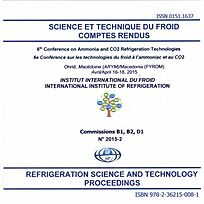
IIR document
Internal reversible ammonia air-to-water heat pump/chiller.
Number: pap. n. 30
Author(s) : NIELSEN G., RASMUSSEN C.
Summary
This paper will give an account of the background for and the stages in the development of an internally reversible ammonia air-to-water heat pump / chiller. (IRAW HP) The background for the development of the first version was a project where the specification demanded an ammonia chiller system that also could be used as a heat pump. There is neither river nor seawater available, boreholes where excluded partly due to fiscal considerations (investment cost app. €300 000), partly because the necessary ground area was not available. Therefore the heat dump / heat source had to be air. The solution suggested by the contractors included two chillers that would operate as a two stage system, but with a glycol circuit in between, and a dry cooler system as heat source. The overall system efficiency at design outdoor temperature of -8°C and a heat delivery temperature of 50°C was very low, as temperatures went up and down in the system configuration. The idea of moving the reversible action into the chiller unit was inspired by the defrost system of critically charged systems, developed by Star Refrigeration, but somewhat modified in the final design. Since this first system, the design has evolved, and further two systems have been supplied to the Bergen area in Norway and a fourth is under way, in yet a modified design.
Available documents
Format PDF
Pages: 6 p.
Available
Public price
20 €
Member price*
Free
* Best rate depending on membership category (see the detailed benefits of individual and corporate memberships).
Details
- Original title: Internal reversible ammonia air-to-water heat pump/chiller.
- Record ID : 30014636
- Languages: English
- Source: 6th Conference on Ammonia and CO2 Refrigeration Technology. Proceedings: Ohrid, North Macedonia, April 16-18, 2015.
- Publication date: 2015/04/16
Links
See other articles from the proceedings (53)
See the conference proceedings
Indexing
-
Themes:
Heat pumps techniques;
Ammonia;
Chillers - Keywords: Design; Reversibility; Chiller; Ammonia; Air-water; Heat pump; Norway
-
Unutrašnja reverzibilna amonijacna toplotna pum...
- Author(s) : NIELSEN G., RASMUSSEN C.
- Date : 2016/12
- Languages : Serbian
- Source: 47th International HVAC&R Congress and Exhibition.
- Formats : PDF
View record
-
A residential ammonia heat pump: comparison wit...
- Author(s) : JONASSEN O., HARDARSON V.
- Date : 2006/05/29
- Languages : English
- Source: 7th IIR-Gustav Lorentzen Conference on Natural Working Fluids (GL2006). Proceedings
- Formats : PDF
View record
-
Transient simulation of an air-source heat pump...
- Author(s) : LIU Z. Q., TANG G. F., ZHAO F. Y.
- Date : 2003/04/22
- Languages : English
- Source: Cryogenics and refrigeration. Proceedings of ICCR 2003.
View record
-
Whole life emission for air to water heat pumps...
- Author(s) : COLOMBO I., MAIDMENT G. G., COWAN D.
- Date : 2015/08/16
- Languages : English
- Source: Proceedings of the 24th IIR International Congress of Refrigeration: Yokohama, Japan, August 16-22, 2015.
- Formats : PDF
View record
-
Borehole installations or air to water heat pum...
- Author(s) : NIELSEN G.
- Date : 2015/04/16
- Languages : English
- Source: 6th Conference on Ammonia and CO2 Refrigeration Technology. Proceedings: Ohrid, North Macedonia, April 16-18, 2015.
- Formats : PDF
View record
